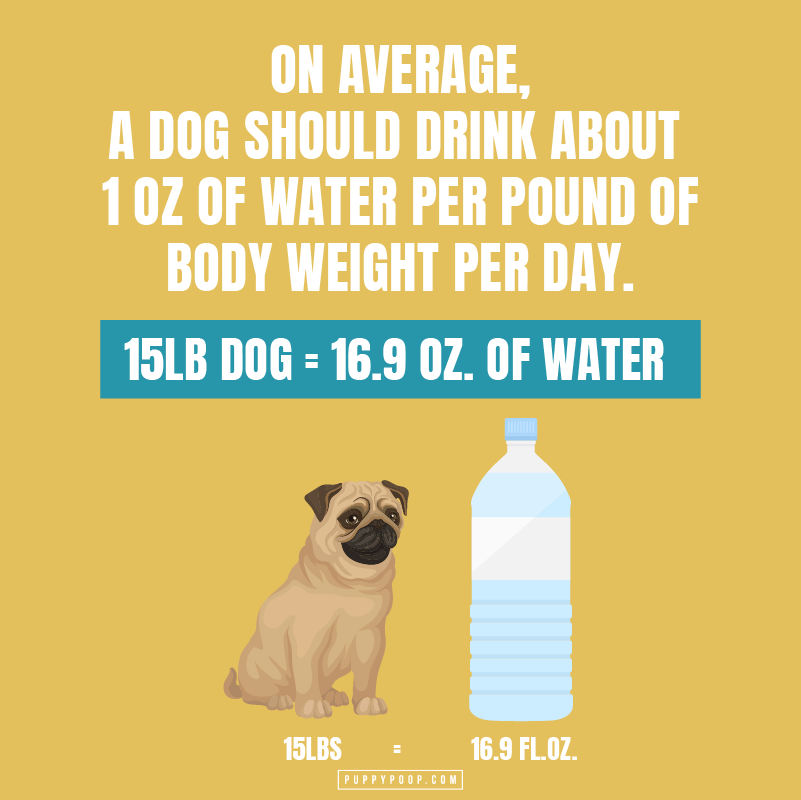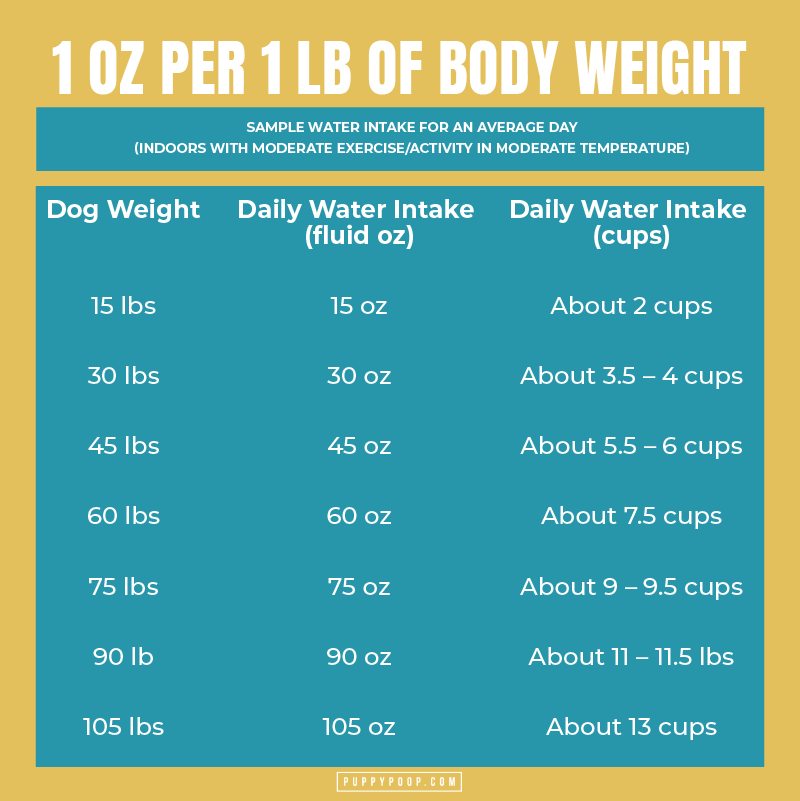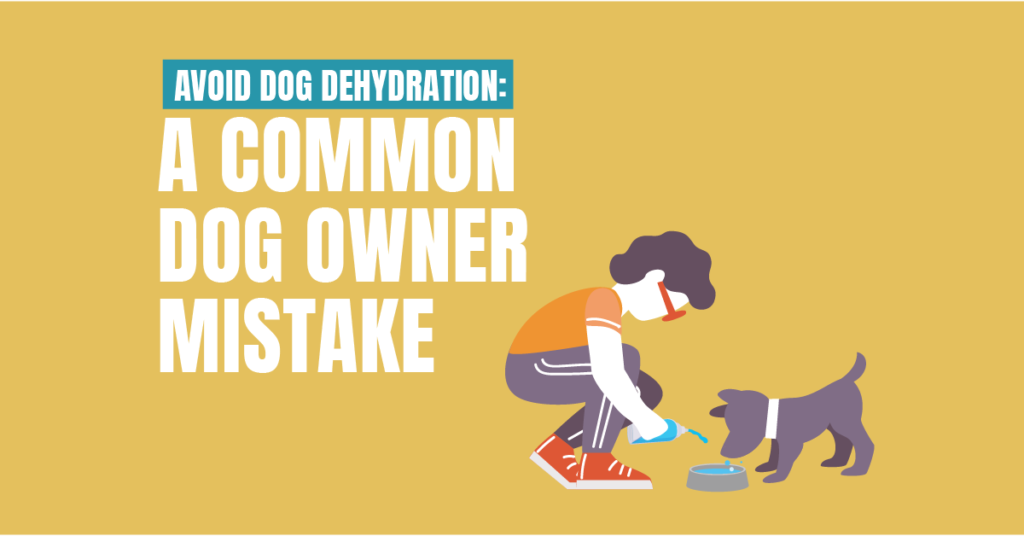The temperature is getting warmer and the weather is becoming increasingly nice outside. All your favorite outdoor activities, especially those including your dog, are in full swing. From park play to weekend hikes with your dog, nothing can be as refreshing or keep your pet fueled as a drink of water to avoid dog dehydration.
Water is critical to a dog’s physiology, and can almost be thought of as the fourth macronutrient (along with protein, fat, and carbohydrates).
Like humans, dogs are made up of almost 80% water which is why staying hydrated is vital for a happy, healthy dog. Summer temperatures and heat spark an important topic to discuss: avoiding dog dehydration.

How much water should a dog drink?
On average, a dog should drink about 1 oz of water per pound of body weight per day. There are eight fluid ounces in one cup so the below table can be used directionally as a quick guide. For reference, common bottle water brands typically hold 16.9 fluid oz of water per bottle. According to the table, a 15 lb dog should be hydrating with about one bottle of water per day. Find your dog’s daily dog hydration needs on our time-saving chart and read the important note below.

NOTE: There are many instances where the above rule of thumb should be increased (sometimes exponentially), including adjustments for temperature, amount of physical activity, medications, diet, age, and more. For example, a dog who is on a dry food diet may drink more water than one on a wet, cooked, or raw diet where over 70% of the food includes moisture and water content. Working or highly active dogs, puppies, as well as dogs living in warm temperatures should also consume much more than the average daily volume mentioned above. These are just some examples of when dog dehydration can occur more easily and when how much water a dog should drink per day needs to be increased.
Signs of dog dehydration
The signs of dehydration in dogs are similar to humans and may include some of the below. Although, in speaking with hundreds of dog owners, we’ve found many of us pet parents have a general sense that our dogs are not fully hydrated on a regular basis (interesting fact: dogs sweat through their paws!):
- Volume (and frequency) of pee
- Concentration of pee (yellow color and strong odor)
- Dry with little elasticity in skin
- Dry nose and sunken eyes
- Excessive panting or thick saliva
- Reduced energy or lethargy versus normal
- Diarrhea or vomiting
If you suspect your dog is dehydrated it’s important to closely monitor her and prioritize increasing her water intake. If you suspect a serious case of dog dehydration, contact your veterinarian. There are support options available in extreme cases, including administering subcutaneous fluids or IVs.
5 Tips for Avoiding Dog Dehydration
Provide fresh drinking water in a clean bowl.
If we wouldn’t want to drink stale water, why would our dog? Clean, fresh water in a clean bowl is key. We recommend stainless steel bowls as they are more sanitary and generally harbor fewer bacteria than their plastic or ceramic counterparts. You should wash your dog’s water bowl with hot, soapy water each day to keep things sanitary. It also helps reduce the chance of bad bacteria growing.
Offer multiple water bowl options and locations!
Our dogs are notoriously lazy sometimes and so having multiple access points to fresh, clean water can be key to avoiding dog dehydration. Place water bowls in areas that your dog frequents, including their crate, kitchen, bedrooms or offices to encourage regular hydration sessions.
If you are outside with your dog for extended periods of time, high levels of activity, or in warmer weather, remember to bring a water bowl for her and encourage frequent drinking breaks. Bring an extra water bottle or jug when you head out the door to avoid trying to find water once you’re out and about.
Rehydrate dry food by adding water directly to mealtime.
Dry dog food is particularly convenient to store because it is exactly that – dry! During the extrusion process of manufacturing kibble, water is removed from the ingredients even though it is a vital part of a dog’s health. Adding a few ounces of water directly into your dog’s food bowl will help to avoid dog dehydration. This will also enable more optimal digestion and nutrient absorption as the food passes through your dog’s digestive tract.
You can also avoid dog dehydration by feeding Fido foods with a higher moisture content. Cooked, raw, and canned foods all have higher water content in comparison to kibble, about 70-80% vs. 7-10% respectively. Dogs on non-dry food diets tend to stay more hydrated because they are naturally intaking more moisture when they eat.
Add some fun, easy crunch!
Some dogs love the cool crunch of ice cubes or chunks, especially in the hot, humid summer months. This is an effortless way to increase your dog’s hydration that could be new to them. We also know how much dogs love new things! You can also create frozen cubes of other tasty liquids such as raw milk or kefir. Really, you can go crazy!
DIY pup-sicles or frozen treats with bone broth or fresh food.
If your dog is a treat fiend try freezing some of their favorite treats in bone broth or stock (no sodium!) in an ice cube tray. Other alternatives include pureeing and freezing fruits and veggies or sticking other treats in to make a handle! The options and ideas are really limitless here. Check out Pinterest or other social media platforms for inspiration and ideas.
Avoiding dog dehydration is a daily effort.
Many dogs suffer from mild dog dehydration on a daily basis. Whether it is a summer day full of activities or a lazy day on the couch, follow our 5 tips for avoiding dog dehydration to keep your dog’s bodily systems healthy and working properly.
Get the DIG Labs App
Download the free DIG Labs Digestive Health Tracker to get personalized insights and recommendations for your dog based on their stool.

